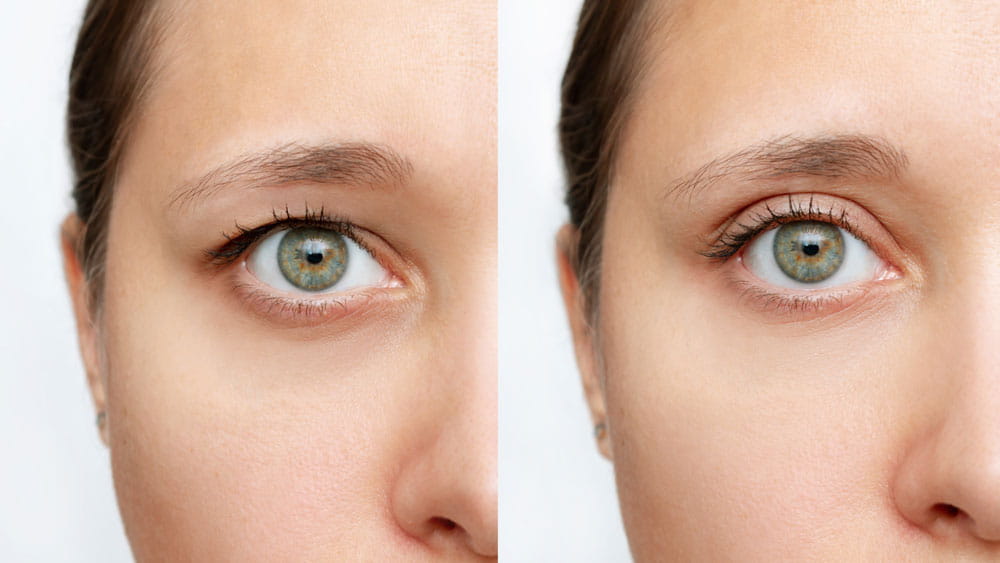What are drooping eyelids?
 Drooping upper eyelids can be a result of sagging skin (dermatochalasis), a stretched eyelid muscle (ptosis), a sagging eyebrow or a combination of factors.
Drooping upper eyelids can be a result of sagging skin (dermatochalasis), a stretched eyelid muscle (ptosis), a sagging eyebrow or a combination of factors.
Eyelid droopiness may cause covering of your eye’s pupil (visual axis), create loss of visual field or make driving or reading difficult. In rare cases, drooping eyelids can also indicate an underlying condition, such as thyroid eye disease (TED) or cancer (in rare circumstances).
Our experienced oculofacial surgeons can help determine what is causing your heavy eyelids, and what custom treatments may be appropriate for you.
What causes droopy eyelids?
Drooping eyelids can be caused by:
- Genetics
- Aging
- Insertion and removal of contact lenses, which over time can stretch the eyelid muscle
Nonsurgical treatment of drooping eyelids
Nonsurgical treatments are suggested for slight droopiness of the eyelids. This can include using eyedrops (daily or as needed), such as Upneeq® (oxymetazoline), or by getting a Botox™ brow lift.
Surgical treatment of drooping eyelids
There are several types of surgeries to fix drooping eyelids. Your provider will recommend one depending on the specifics of your eyelids and severity of your condition. They include:
Upper blepharoplasty
An upper blepharoplasty removes baggy, excess tissue (dermatochalasis) on the upper eyelids. Excess skin can interfere with vision or give the face a tired appearance. Fatty tissue can cause the appearance of puffy eyes.
Ptosis surgery
Ptosis surgery shortens the eyelid muscle to tighten and raise the position of the eyelid. This can expose more of the white and iris of the eye.
Combination surgery
It’s common for patients to have upper blepharoplasty and ptosis surgery at the same time. Excess tissue would be removed and eyelid muscles would be shortened in this straightforward combination surgery.
Cosmetic surgery options
Cosmetic surgery can help create a fresh, more wide-awake appearance. Droopy eyelids may cause a heavy, sleepy appearance that some patients may want to improve. Fixing asymmetry is also an option. This is common in younger patients born with asymmetrical features or is done to correct the results from a previous, unsatisfactory surgery.
- Eyebrow lift: This procedure lifts the eyebrow or forehead, raising the eyelid’s position.
- Lower blepharoplasty: This procedure minimizes “bags under the eyes” or lower eyelid puffiness, and can be performed at the same time as an upper blepharoplasty.
We’re experts at diagnosing, developing and implementing a personalized treatment plan to address your medical and cosmetic concerns.
What happens before and during droopy eyelids surgery
Before surgery, you will be given twilight (partial) sedation. You will remain awake but sleepy, you should not feel any pain, and will still be able to speak and communicate with our team.
We take careful measurements before and throughout surgery to maintain ideal symmetry of your facial appearance.
Blepharoplasty incisions are made externally at the eyelid crease, tissue is removed and stitches are used to close the wound. Typically, dissolvable stitches are used, but your physician may choose to use traditional removable stitches.
Ptosis surgery incisions can be hidden on the underside of the eyelid leaving no visible scar, or, when performed with a blepharoplasty, hidden in the crease of the eyelid. The surgeon accesses the eyelid muscle, shortens it, and then secures it with permanent stitches and closes the wound. Stitches at the point of entry can be either dissolvable or removable.
Recovery after surgery
After surgery, you may return home to rest. You may feel soreness, tightness or pain after the surgery. You’ll be prescribed medication for pain you may experience. Some patients experience blurry vision.
If your doctor closed your incisions with removable stitches, the stitches will be taken out five to 10 days after surgery.
For two weeks, you will have these restrictions to reduce the risk of an infection:
- Don’t use makeup, including mascara, eyeliner, eyeshadow, etc.
- Don’t use a sauna
- Don’t go swimming
- Don’t use contact lenses
Within two to three days, you can resume regular activities. Most people who have the surgery feel ready to go out in public and back to work in about 10 to 14 days. After two weeks, you may still have some bruising around your eyes. Some bruising may linger four to six weeks before fully healing. It's important to keep your eyelid clean and to avoid rubbing the area.
After you’re fully healed, you can expect a more vibrant and less droopy appearance in your eyelids.
Risks of droopy eyelid surgery
As with any surgery, there are some risks or complications. Your doctor will discuss all possible risks with you prior to the procedure, including:
- If too much eyelid skin is removed during a blepharoplasty, this can create the inability to close the eyelids and create risks for dry eye (blepharitis) and eye infections.
- Uneven eyelid creases
To minimize risks and avoid these complications, our expert oculofacial surgeons take precise measurements before and during surgery.
Some patients may have the appearance of “sunken” eyes after surgery. This may be because too much natural fat around the eye socket was removed. Our oculofacial surgeons may perform orbital fat transposition to partially remove or evenly place the fat. This can help prevent “sunken” eyes.
We also perform corrective surgery and skin grafts after previously unsatisfactory surgeries done elsewhere.
Does insurance cover surgery for droopy eyelids?
Most procedures to address a medical issue, such as poor vision caused by droopy eyelids, are covered by insurance. Often cosmetic procedures are not. Please check with your physician or provider to verify your coverage.
Why choose the Ohio State oculofacial team
Our oculofacial surgeons have the expertise to best identify a drooping brow or stretched eyelid muscle (ptosis) and can best recommend the preferred surgery treatment. Having the proper type of surgery ensures the underlying issue causing your droopy eyelids is correctly addressed.
Our oculofacial physicians are the only specialized experts in the care, diagnosis, treatment and surgery for facial eye plastics at The Ohio State University Wexner Medical Center.
Every member of our oculofacial team is board certified and has completed a two-year fellowship in eye plastics from the American Society of Ophthalmic Plastic and Reconstructive Surgery. There are only 750 physicians in the world with this comprehensive training (as of January 2023).

